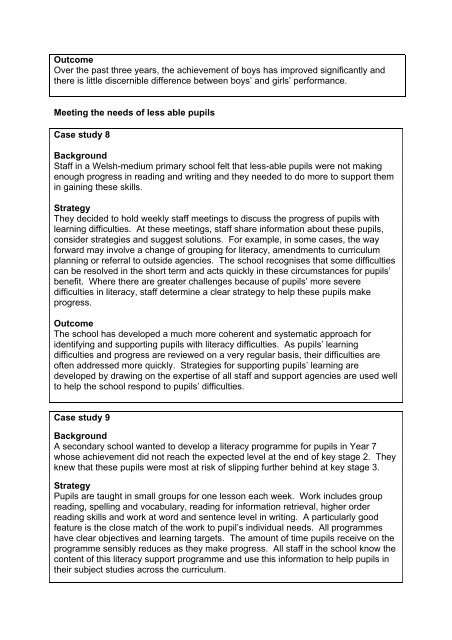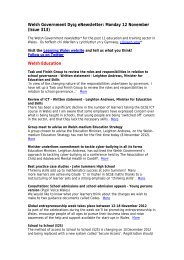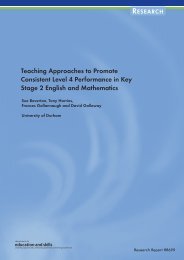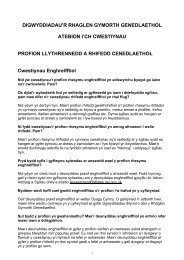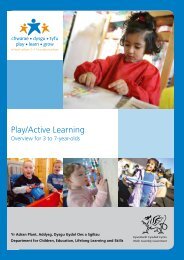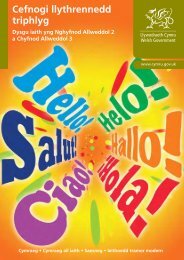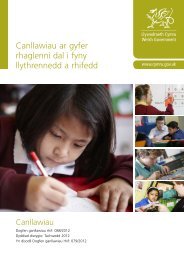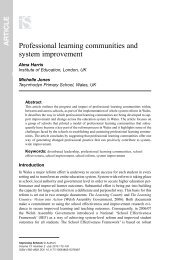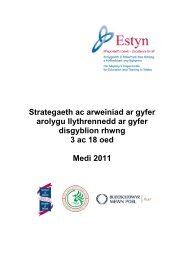Best practice in the reading and writing of pupils aged 7 to 14 ... - Estyn
Best practice in the reading and writing of pupils aged 7 to 14 ... - Estyn
Best practice in the reading and writing of pupils aged 7 to 14 ... - Estyn
Create successful ePaper yourself
Turn your PDF publications into a flip-book with our unique Google optimized e-Paper software.
OutcomeOver <strong>the</strong> past three years, <strong>the</strong> achievement <strong>of</strong> boys has improved significantly <strong>and</strong><strong>the</strong>re is little discernible difference between boys’ <strong>and</strong> girls’ performance.Meet<strong>in</strong>g <strong>the</strong> needs <strong>of</strong> less able <strong>pupils</strong>Case study 8BackgroundStaff <strong>in</strong> a Welsh-medium primary school felt that less-able <strong>pupils</strong> were not mak<strong>in</strong>genough progress <strong>in</strong> read<strong>in</strong>g <strong>and</strong> writ<strong>in</strong>g <strong>and</strong> <strong>the</strong>y needed <strong>to</strong> do more <strong>to</strong> support <strong>the</strong>m<strong>in</strong> ga<strong>in</strong><strong>in</strong>g <strong>the</strong>se skills.StrategyThey decided <strong>to</strong> hold weekly staff meet<strong>in</strong>gs <strong>to</strong> discuss <strong>the</strong> progress <strong>of</strong> <strong>pupils</strong> withlearn<strong>in</strong>g difficulties. At <strong>the</strong>se meet<strong>in</strong>gs, staff share <strong>in</strong>formation about <strong>the</strong>se <strong>pupils</strong>,consider strategies <strong>and</strong> suggest solutions. For example, <strong>in</strong> some cases, <strong>the</strong> wayforward may <strong>in</strong>volve a change <strong>of</strong> group<strong>in</strong>g for literacy, amendments <strong>to</strong> curriculumplann<strong>in</strong>g or referral <strong>to</strong> outside agencies. The school recognises that some difficultiescan be resolved <strong>in</strong> <strong>the</strong> short term <strong>and</strong> acts quickly <strong>in</strong> <strong>the</strong>se circumstances for <strong>pupils</strong>’benefit. Where <strong>the</strong>re are greater challenges because <strong>of</strong> <strong>pupils</strong>’ more severedifficulties <strong>in</strong> literacy, staff determ<strong>in</strong>e a clear strategy <strong>to</strong> help <strong>the</strong>se <strong>pupils</strong> makeprogress.OutcomeThe school has developed a much more coherent <strong>and</strong> systematic approach foridentify<strong>in</strong>g <strong>and</strong> support<strong>in</strong>g <strong>pupils</strong> with literacy difficulties. As <strong>pupils</strong>’ learn<strong>in</strong>gdifficulties <strong>and</strong> progress are reviewed on a very regular basis, <strong>the</strong>ir difficulties are<strong>of</strong>ten addressed more quickly. Strategies for support<strong>in</strong>g <strong>pupils</strong>’ learn<strong>in</strong>g aredeveloped by draw<strong>in</strong>g on <strong>the</strong> expertise <strong>of</strong> all staff <strong>and</strong> support agencies are used well<strong>to</strong> help <strong>the</strong> school respond <strong>to</strong> <strong>pupils</strong>’ difficulties.Case study 9BackgroundA secondary school wanted <strong>to</strong> develop a literacy programme for <strong>pupils</strong> <strong>in</strong> Year 7whose achievement did not reach <strong>the</strong> expected level at <strong>the</strong> end <strong>of</strong> key stage 2. Theyknew that <strong>the</strong>se <strong>pupils</strong> were most at risk <strong>of</strong> slipp<strong>in</strong>g fur<strong>the</strong>r beh<strong>in</strong>d at key stage 3.StrategyPupils are taught <strong>in</strong> small groups for one lesson each week. Work <strong>in</strong>cludes groupread<strong>in</strong>g, spell<strong>in</strong>g <strong>and</strong> vocabulary, read<strong>in</strong>g for <strong>in</strong>formation retrieval, higher orderread<strong>in</strong>g skills <strong>and</strong> work at word <strong>and</strong> sentence level <strong>in</strong> writ<strong>in</strong>g. A particularly goodfeature is <strong>the</strong> close match <strong>of</strong> <strong>the</strong> work <strong>to</strong> pupil’s <strong>in</strong>dividual needs. All programmeshave clear objectives <strong>and</strong> learn<strong>in</strong>g targets. The amount <strong>of</strong> time <strong>pupils</strong> receive on <strong>the</strong>programme sensibly reduces as <strong>the</strong>y make progress. All staff <strong>in</strong> <strong>the</strong> school know <strong>the</strong>content <strong>of</strong> this literacy support programme <strong>and</strong> use this <strong>in</strong>formation <strong>to</strong> help <strong>pupils</strong> <strong>in</strong><strong>the</strong>ir subject studies across <strong>the</strong> curriculum.


